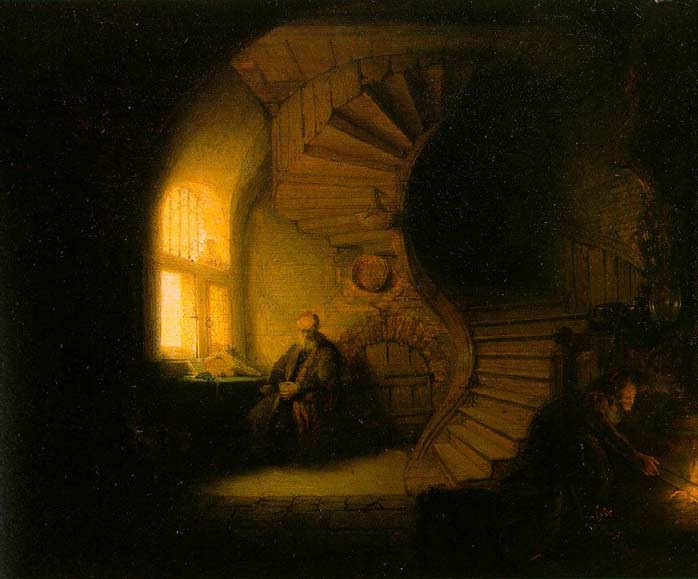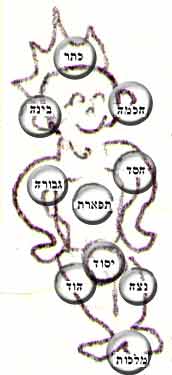God the Sinner
The Kabbalah represents a Copernican revolution. This theology
is not a continuation of what has gone before, it does not fall
within the parameters of Biblical theology. Recall, in the Bible,
God is wholly good, and man is a sinner who must repent to restore sundered fellowship. In the
Kabbalah, God is the sinner; He is broken, and man (meaning here,
only Jewish men) must repair him. Kabbalah inverts the Biblical
relation between God and man:
"'He [Isaac Luria] offered his followers a profoundly
disturbing secret: he helped them understand the nature of evil and
the means by which it would eventually be overcome.' God, too, was
understood as grappling with evil. . .Luria's teachings spread
quickly through the traumatized Jewish world. In an ingenious leap
of religious imagination, Luria enabled Jews to transcend their
recent experience of catastrophe by positing a primordial
catastrophe — tsimtsum — in which elements of the Divine Being
were splintered into an infinity of broken pieces. These 'shards'
are the stuff of creation. The purpose of creation, this splintering
of God, was seen as nothing less than, in Silberman's words,
'destroying the principle of evil from within.' Once this shattering
of the divine has occurred, it becomes the responsibility not of a
single Messiah but of the Jewish people to bring about the gradual
restoration of cosmic unity and God's own being, the ultimate
ingathering of those broken pieces — a redemptive process that is
called tikkun olam." (James Carroll, Constantine's Sword, p. 388).
This is the great secret hid behind the veil: God is evil, man
is good. Not to worry, man has the tools in his hand to remold and
repair God, remaking Him after his own image. This alarming message appeals
to some people: people who didn't like the old way, people who hate God
and are inordinately fond of themselves, people who take offense at John
the Baptist's cry, 'Repent!'
God created the world and pronounced His creation "good." The
free will of the creatures led to their defection. Even the fallen
angels were not created evil, but chose their own course; they
wanted to go that way. The Kabbalah promises not only man's, but also God's salvation,— not salvation by the grace of God,—
but His own salvation! It had not previously been known
that He, like His creatures, stood in need of it:
"The Zohar too takes the position that the crux of the redemption works itself out in the
uninterrupted conjunction of Tiferet and Malkhut, and that redemption of Israel is one with the redemption
of God Himself from His mystic exile. The source of this belief is talmudic and can be found in both the Palestinian
Talmud, Sukkah 4, 3 and in the Midrash Lev. R. 9, 3: 'The salvation of the Holy One blessed
be He is the salvation of Israel.'" (Gershom Scholem, Kabbalah, p. 166)
Christians are familiar with the idea that Adam's fall ruined our own
hopes for happiness; the Kabbalah adds the new wrinkle that Adam's fall
sundered God:
"And this is the tiqqun [healing,
restoration] of the world and the restoration of all things to their pristine state,
as they were before Adam sinned. For then all the worlds were perfectly
balanced and co-ordinated, and the Great Name [that is,
God] was in perfect union with his glorious Shekhinah. But by
Adam's sin the unity was disrupted, the buildings destroyed,
and the world corrupted, so that the innermost things were
turned out and the outward things penetrated inside and the
spirit of uncleanness spread over the world, as a result of
which humankind sinned further, hewed down the beautiful
plantations, and sundered the holy union." (Ibn Gabbay,
quoted pp. 47-48, Sabbatai Sevi: The Mystical Messiah, by Gershom
Scholem.)
Teaching like this, which has man healing a God wounded by evil,
is an abomination.

Tsaddik
The reader has already encountered "the sacred marriage of Tsaddik and the Shekhinah." Having discovered
that this system is based on a mapping of divine potencies to a human/divine stick figure, as sketched above, the reader
can exercise his imagination to discern which of God's body parts is the
Tsaddik. Anatomically accurate imagery of God, and the celebration
of this particular bodily organ, is by no means unique to the Kabbalah;
Justinus the gnostic celebrated the same thing:
"Now the Good One is Priapus, (and) he it is who
antecedently caused the production of everything that exists. On
this account he is styled Priapus, because he previously fashioned
all things (according to his own design). For this reason, he says,
in every temple is placed his statue, which is revered by every
creature; and (there are images of him) in the highways, carrying
over his head ripened fruits, that is, the produce of the creation,
of which he is the cause, having in the first instance formed,
(according to His own design), the creation, when as yet it had no
existence." (Hippolytus, The Refutation of All Heresies, Book 5,
Chapter 21).
Worship of this unique feature is part of the Kabbalah's heritage
from gnosticism. This bodily part also makes peace within God, ensuring His unity, or
rather such divine unity as this system permits:
"As the Tsaddik awakens the world to repent or to fix that which is not whole, this attribute is
called Peace, mediating for good between YHVH and Adonai, making peace between them and bringing them near to dwell
together without separation or breaking up in the world; and at that hour we find that God is one."
(Sha'arei Orah, f. 22b, quoted p. 104, Gershom Scholem, 'On the Mystical Shape of the Godhead.')
Tsaddik is also the righteous man, praised by the rabbis as the foundation of the world. At times there is confusion
between this righteous man, a created being, and the bodily part/power or logos of God, the divine Washington Monument so to
speak. The two are effectively identified in this passage:
"What is the eighth? The Holy One, blessed be He, has one righteous man in His world, and he is very precious
to Him, because he maintains the whole world and he is its foundation. . .He is loved and treasured above, loved and treasured below;
feared and sublime above, feared and sublime below; comely and accepted above, comely and accepted below; and he is the foundation of
all souls. You say that he is the eighth [logos] and that he is the foundation of all souls?"
(Sefer ha-Bahir, quoted p. 94, Gershom Scholem, 'On the Mystical Shape of the Godhead.')
Is the Tsaddik here a man created in the image of God, or a divine potency/body part?
That it must be read as both seems to be the whole point of this enterprise,
which drags God down from heaven and exalts man to the heavenlies. While
everything in the sphere above is mirrored in the sphere below, it
often seems that the 'active' sphere which governs the system is the
one below; it is from here below that Israel proposes to repair God. And do
not think 'man' means 'humanity.' Though there is a whole department
of the publishing industry devoted to promoting the fiction that
gnosticism is feminism, the Kabbalah is not feminist-friendly: ". .
.all females belong to the 'left side,'" (Gali Razaya, quoted p. 62,
Gershom Scholem, Sabbatai Sevi: The Mystical Messiah).
In the present day atheists rail against God, pointing to every deformed
child as evidence of His cruelty and/or incompetence. When asked, 'Why
are you so angry at God?, the atheists object, plausibly enough, 'How can
I be angry at Him when I don't believe He exists?' Today's atheism attracts
the 'I hate God' constituency, but then leaves them perplexed at their
own irrationality. In days gone by there was a religion which fit this
constituency's needs far more closely than atheism: gnosticism. This tendency
portrayed the God of the Bible, the God with whom humanity has to deal,
the God who rules our world, as fallen, incompetent, and unworthy of worship,
holding up in His place a stranger God far, far away as the God after man's
own heart, the God who deserves our love and worship. The Kabbalah adopts
the gnostic attitude and fits it within the confines of Jewish piety. The
Deist god, 'Ein Sof,' is allowed to be God, but for the rest Israel's God is unveiled as man
writ large. This religion is atheism wearing a broad-brimmed hat.
Those who understand this convoluted and elaborate system best understand
it intends to deconstruct the God of the Bible: "Was God originally
anything more than the Adam Kadmon?" (Harold Bloom, 'Omens of Millenium,'
p. 205). The Kabbalists dislike being expected to bow down to a party who
has absented Himself; thus the battle-cry of their religion: 'Hear, O Israel,
your God is. . .Yourself.'
If this seems harsh, consider the Kabbalistic ideal of prophecy. In Kabbalah,
the prophet encounters. . .himself:
"'The deeply learned Rabbi Nathan, of blessed memory, said to me: Know that the complete secret of
prophecy to a prophet consists in that he suddenly sees the form of his self standing before him. . .And the learned sage R.
Abraham ibn Ezra, of blessed memory, said "The one who hears [at the time of prophecy] is a human being, and the one who
speaks is a human being."'
. . .This is the experience of the prophets, whose own pure 'self' conveys to them the prophetic tiding. What they encountered
was not essentially different from themselves; what was sent to them was not a divine apparition or an angel, but their own pure
form." (Gershom Scholem, 'On the Mystical Shape of the Godhead,' pp. 253-254).
Several of the imposter Messiahs who have afflicted Israel have been Kabbalists:

|




